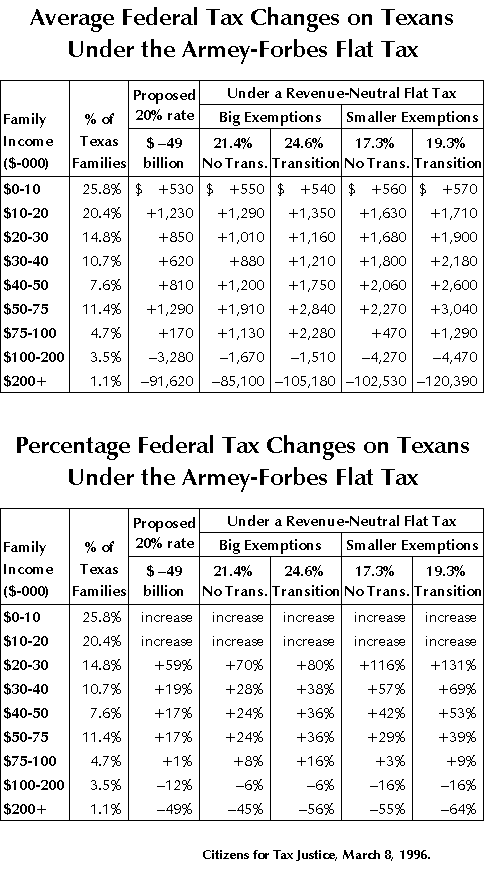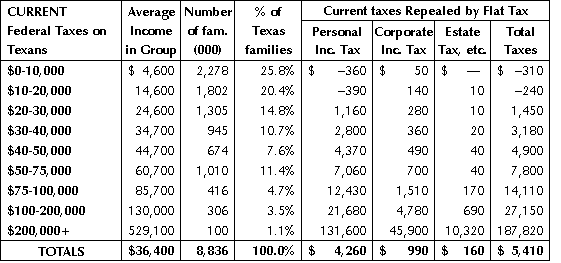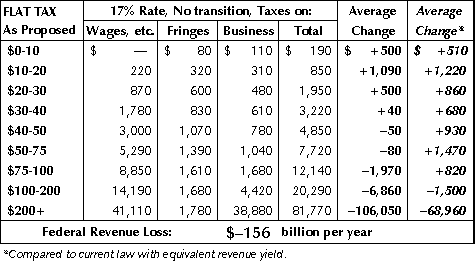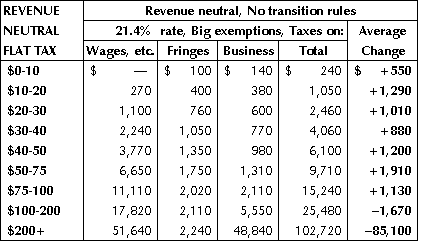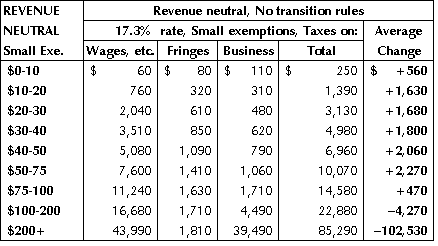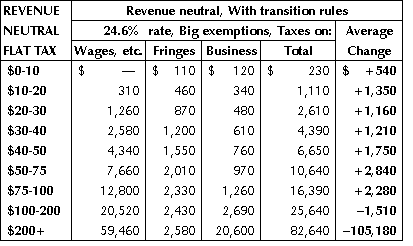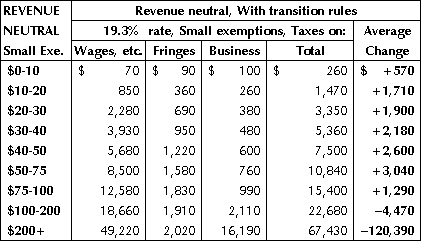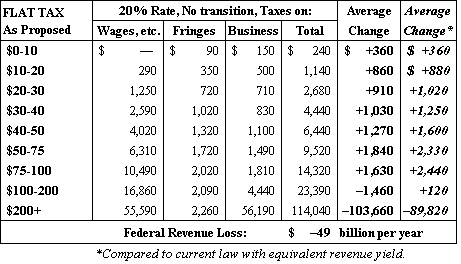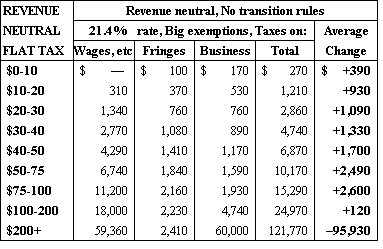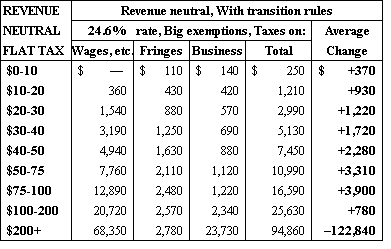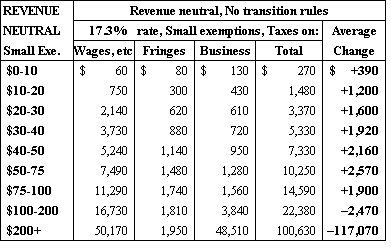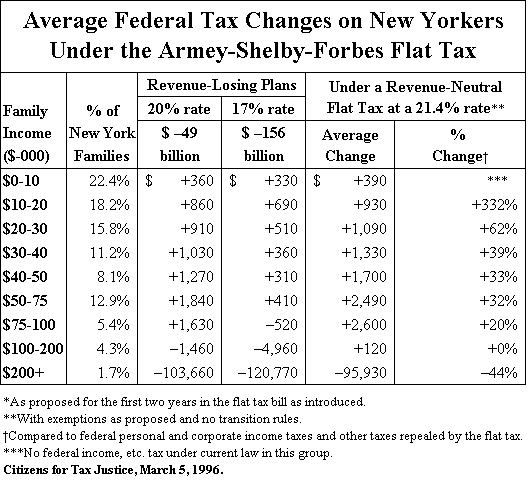March 8, 1996 02:25 PM | Permalink | 
Flat tax legislation sponsored by Rep. Dick Armey (R-Tex.) and endorsed by presidential candidate Malcolm S. “Steve” Forbes, Jr. would raise taxes on the vast majority of Texas families, while showering enormous tax cuts on very wealthy people such as Forbes himself.
Armey’s flat tax bill calls for a 20% tax on wages, fringe benefits and self-employment earnings, with exemptions for interest, dividends and capital gains. The flat tax rate is supposed to fall to 17% after two years–the figure usually cited by Forbes–but, in fact, the rate would actually have to be considerably higher than the proposed 20% to avoid enormous additions to the federal budget deficit.
A computer microsimulation analysis of the effects of the Armey-Forbes flat tax plan on Texans by Citizens for Tax Justice finds that under the plan at its proposed 20% tax rate:
- Federal revenues would plummet by at least $49 billion a year.
- Despite these huge revenue losses, the vast majority of Texans–all income groups but the top 4.6% of Texas families–would pay higher federal taxes.
- In contrast, the very best-off Texans–the 1.1% making more than $200,000 a year–would see their federal taxes cut in half.
CTJ also found that if the flat tax rate is increased to avoid revenue losses:
- Federal taxes would increase on all Texas income groups except the best off 1.1%.
- Texans in the $20,000 to $75,000 income ranges would face tax increases of 24% to 70%. That would mean $900 to $1,900 a year in higher federal taxes for these families.
(A February CTJ analysis found that under his flat tax plan, Steve Forbes personally would save a total of $1.9 billion over the rest of his lifetime.)
“Because the flat tax cuts taxes so drastically on super-rich people like Steve Forbes, it inevitably means much higher burdens on everyone else,” noted CTJ director Robert S. McIntyre. “Our new analysis quantifies the size of those increased burdens on residents of Texas.”

*As proposed for the first two years in the flat tax bill as introduced.
**With exemptions as proposed and no transition rules.
+Compared to federal personal and corporate income taxes and other taxes repealed by the flat tax.
++ No federal income, etc. tax under current law in this group.
Citizens for Tax Justice, March 8, 1996.
Description of the Armey-Forbes Flat Tax Proposal
Armey and Forbes have proposed to repeal the federal personal income tax, the corporate income tax and the estate tax, and replace them with a 20% flat tax (scheduled to drop to 17% after two years) on wages, pensions and self-employment income. (Forbes typically talks only about the 17% eventual rate, but a spokesman for his campaign told Fortune, Feb. 5, that his flat tax plan “would duplicate” the Armey plan.)
The new flat tax would also be imposed on employer-paid fringe benefits, including benefits paid by state and local governments and non-profit organizations. Individuals would no longer be taxed on their interest, dividends, capital gains and other “unearned” income. All itemized deductions, for state and local taxes, mortgage interest, charitable donations and so forth would be repealed, as would all federal tax credits.
Although the flat tax offers large exemptions against the wage portion of its tax–$10,700 per taxpayer and $5,000 per dependent in 1996 dollars–it taxes fringe benefits such as health insurance and employer-paid social security taxes with no exemptions. As a result, lower-income working families that now owe no federal income tax will pay substantial taxes under the flat tax.
Businesses would file tax returns similar to those currently filed, except that: interest and dividends income would be exempt from taxation; capital expenditures would be deducted immediately rather than depreciated over time; interest paid would no longer be deductible; and 100% of meals and entertainment outlays (rather than only 50% under current law) could be deducted.
In the aggregate, these changes in corporate taxation would eventually appear to wipe out most taxes on corporations. Flat tax proponents, however, claim their plan would raise large amounts from business. That claim is based on the absurd notion that companies that have invested heavily in recent years would be subject to huge tax penalties on their past investments (due to loss of depreciation deductions).
The Armey-Forbes flat tax plan’s cavalier attitude about business taxation has been sharply criticized as unfair and irrational. Indeed, the almost random effects on different businesses from the lack of “transition rules” could cause huge economic dislocations and a sharp downturn in the economy. That is why even the otherwise pro-flat tax Kemp Commission report called for “generous” transition rules as part of any tax overhaul.
Plan as proposed promises huge deficits, economic dislocations
As proposed, the flat tax would add an estimated $49 billion to the annual federal budget deficit at its proposed 20% tax rate, with the loss ballooning to $156 billion a year at the eventual 17% tax rate. These “static” estimates almost certainly vastly understate the likely revenue losses, however. Any practical flat-tax plan would undoubtably provide substantial transition rules, and there would also be a wave of corporate merging and leasing activities to avoid the new flat tax.
Huge increases in the budget deficit would drive up interest rates, and throw the economy into recession. Alternatively, were the federal government to try to offset these huge deficit increases through program reductions, that would require cuts in federal programs even larger than those contemplated in last year’s congressional budget plan. Under that legislation, not only were Medicare and Medicaid under assault, but state and local government were expected to lose huge amounts in federal aid.
Alternative Scenarios Show Similar Results
Besides comparing the revenue-losing Armey-Forbes flat tax plan as proposed to current law, CTJ also looked at alternative “revenue-neutral” flat tax scenarios, including ones that assume either explicit transition rules to avoid driving large numbers of companies out of business or substantial corporate merger and leasing transactions that achieve the same result. Under these more likely scenarios, CTJ found that the flat tax could potentially break even at a 24.6% tax rate with the wage-tax exemptions proposed in the Armey bill. CTJ also found that if the wage-tax exemptions were reduced to $5,100 per taxpayer and $2,400 per dependent, the plan could potentially break even at a 19.3% rate.
No matter which alternative scenario is chosen, most Texans would pay much higher taxes under the flat tax, with average tax increases in the $30,000 to $100,000 income groups ranging from $900 a year to more than $3,000 annually.
“There’s no free lunch here,” noted McIntyre. “If the flat tax is designed to cut taxes by $150 billion or $200 billion a year, that will mean doubling the deficit or huge reductions in federal services, coupled with higher taxes on most families, higher interest rates and, most likely, a deep recession. If the flat tax rate is increased or its exemptions are lowered to try to break even, then almost everyone’s taxes except the very rich’s must go up even more.”
Source:
CTJ’s analysis of the Armey-Forbes flat tax was computed using the Institute on Taxation and Economic Policy’s Microsimulation Tax Model, a tax simulation model similar in design and data sources to those used by the Treasury Department and the congressional Joint Committee on Taxation, but also equipped to analyze the effects of tax changes on a state-by-state basis.
![]()
